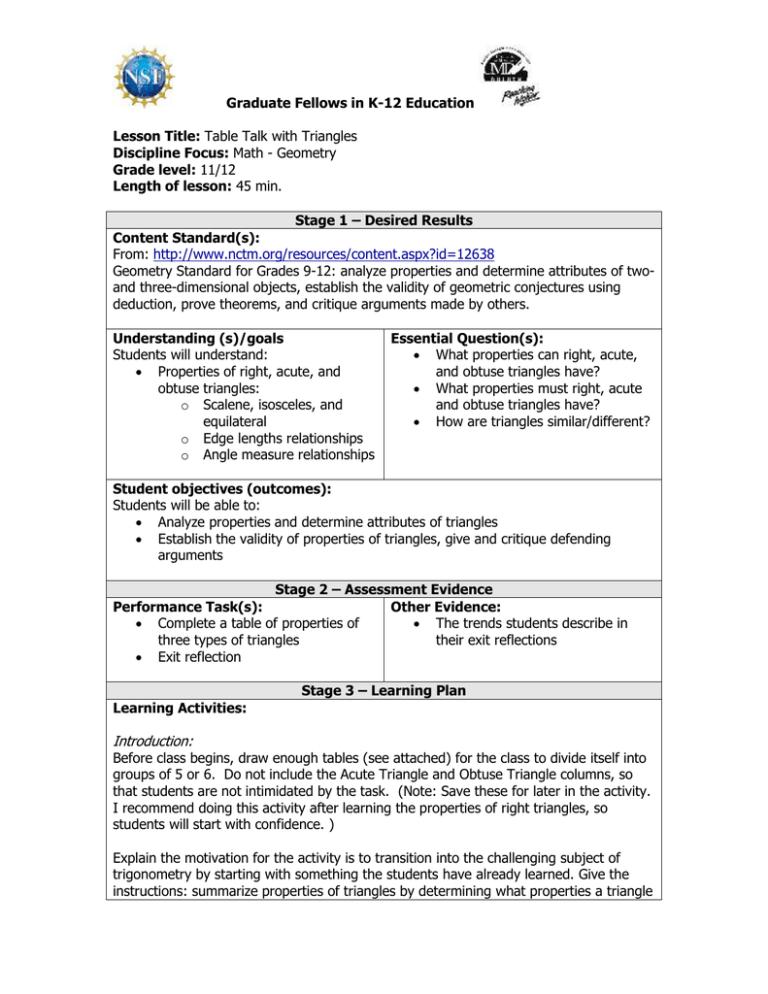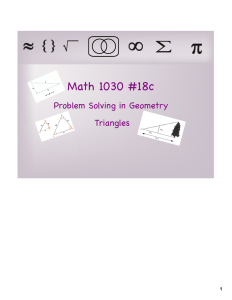Table Talk with Triangles
advertisement

Graduate Fellows in K-12 Education Lesson Title: Table Talk with Triangles Discipline Focus: Math - Geometry Grade level: 11/12 Length of lesson: 45 min. Stage 1 – Desired Results Content Standard(s): From: http://www.nctm.org/resources/content.aspx?id=12638 Geometry Standard for Grades 9-12: analyze properties and determine attributes of twoand three-dimensional objects, establish the validity of geometric conjectures using deduction, prove theorems, and critique arguments made by others. Understanding (s)/goals Students will understand: Properties of right, acute, and obtuse triangles: o Scalene, isosceles, and equilateral o Edge lengths relationships o Angle measure relationships Essential Question(s): What properties can right, acute, and obtuse triangles have? What properties must right, acute and obtuse triangles have? How are triangles similar/different? Student objectives (outcomes): Students will be able to: Analyze properties and determine attributes of triangles Establish the validity of properties of triangles, give and critique defending arguments Stage 2 – Assessment Evidence Performance Task(s): Other Evidence: Complete a table of properties of The trends students describe in three types of triangles their exit reflections Exit reflection Stage 3 – Learning Plan Learning Activities: Introduction: Before class begins, draw enough tables (see attached) for the class to divide itself into groups of 5 or 6. Do not include the Acute Triangle and Obtuse Triangle columns, so that students are not intimidated by the task. (Note: Save these for later in the activity. I recommend doing this activity after learning the properties of right triangles, so students will start with confidence. ) Explain the motivation for the activity is to transition into the challenging subject of trigonometry by starting with something the students have already learned. Give the instructions: summarize properties of triangles by determining what properties a triangle Graduate Fellows in K-12 Education has. Give some history: At one point these were new discoveries and they were initially based on a hunch then defended and validated. Instruct students to form groups of their choosing at each of the tables. (5 minutes) Learning Activities: Students should be encouraged to convince each other of their answers. Tell them to ask each other “Why?”, because if they can’t defend their answer, then it might not be correct. Students should be most familiar with right triangles and so will probably finish quickly. They should also be aware of the definitions of acute and obtuse triangles but not necessarily their properties. (Note: As algebra juniors and seniors, they will have learned this vocabulary at some point, so at least one student in each group will probably remember it. If not, we can fill in the blanks as we circulate between the groups.) When they’re finished with right triangle properties, have them create a column for acute triangles. Then when their finished with that, add an obtuse triangle column and complete it. (35 minutes) While the students work, circulate through the groups. Some of the properties are more difficult to determine than others. Make sure they are giving and critiquing arguments each other’s arguments. Encourage them to draw many triangles (they may need protractors/rulers). Conclusion: Let students work almost the entire time. Go over each group’s results with them while the others continue working. They will probably finish around the same time but with enough time in between to visit each group a last time. For the last five minutes, have the students take their seats and ask them to describe on a sheet of paper one trend they observe in the properties tables (This is the exit reflection.). (5 minutes) Graduate Fellows in K-12 Education



